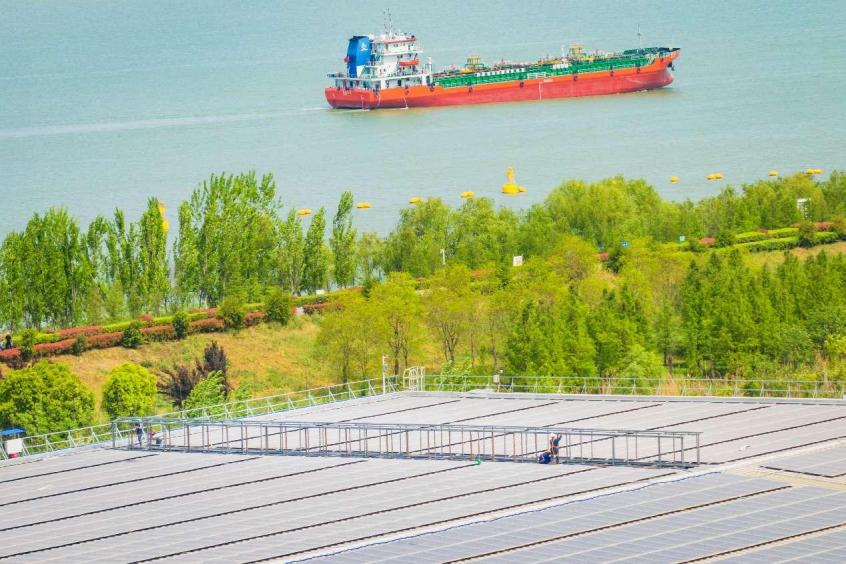




- BRNN
- BRI News
- BRNN News
- Database
Official Documents Polices and Regulations
Inter-government Documents International Cooperation BRI Countries
Business Guide Economic Data BRI Data
Trade
Investment Projects Latest projects
Cases - Content Pool

Yangtze finless porpoises frolic in the waters near the Gezhouba Hydropower Station in Yichang, central China's Hubei Province, April 8, 2025. (Photo by Wu Chengzhong/People's Daily Online)
May marks the peak breeding season for fish species in key areas of the Yangtze River Basin, including the main river, tributaries, and major connected lakes.
As China's longest river, the Yangtze River plays an indispensable role in the country's ecological well-being. In 2021, a decade-long fishing ban was fully implemented across key conservation areas of the river to restore its ecosystem. Now in its fifth year, the effort is showing tangible results.
According to the latest data, the average fishery resource volume at monitoring sites along the river's main stem rose by 9.5 percent year on year in 2024. From 2021 to 2024, 344 native fish species were monitored in the basin, an increase of 36 species compared to the 2017 to 2020 period which preceded the fishing ban.
Supported by conservation efforts across the entire basin, the Yangtze River is gradually recovering its ecological vitality and fostering renewed harmony between human activities and natural systems.
Early in the morning in Jiangtun bay of Yangye township, Ezhou, central China's Hubei Province, several Yangtze finless porpoises frolicked in the river, occasionally poking their heads above the water.
"The water quality has improved a lot in recent years. These 'smiling angels,' once rarely seen, now appear regularly," said local resident Li Congguo, proudly showing a video clip of the porpoises captured on his phone.

Photovoltaic panels are installed atop a factory building along the Yangtze River in Ma'anshan, east China's Anhui Province. (Photo by Zhang Mingwei/People's Daily Online)
The Yangtze finless porpoise - widely regarded as a flagship species - serves as a critical barometer of the river's ecological health. Jiangtun Bay, with its gentle currents and abundant aquatic resources, is one of the important natural habitats of the porpoise in the river's middle and lower reaches.
"We plan to install panoramic cameras to enable real-time public observation of the porpoises. In the future, we'll also explore eco-tourism and educational initiatives to further promote awareness and protection of the species," said Yan Jian, head of Yangye township.
Conservation efforts are intensifying for other iconic species, including the Chinese sturgeon and Yangtze sturgeon.
For the first time, over one million Chinese sturgeons were released into the river last year, and an estimated 110,000 juveniles successfully migrated to the sea via the Yangtze estuary. In areas like Poyang Lake and Dongting Lake, emergency rescue operations for Yangtze finless porpoises were conducted during dry seasons, combining in-situ and ex-situ protection strategies.
The fishing impacts the livelihoods of more than 200,000 fishermen who lived along the river. How have their lives evolved in the aftermath?
At a "fish-to-farming" base in Huyang township, Dangtu county, Ma'anshan, east China's Anhui Province, Ma Wuyi, in his fifties, was weeding a crab pond. Six years ago, he was a seasoned fisherman. In 2019, as part of a government initiative to relocate fishermen away from the Yangtze River and its tributaries, Ma relinquished his nets and moved into a resettlement community with his family.

Staff members at a conservation base for rare fish of the Fisheries Institute of Sichuan Academy of Agricultural Sciences inspect the health of a Yangtze sturgeon in the upper reach of the Yangtze River. (Photo by Zhang Baolin/People's Daily Online)
The county also launched supportive policies to facilitate career transitions, particularly toward aquaculture. Ma participated in free training courses on fish and crab farming, organized by the county and township governments. To address the challenges of vocational adaptation, Dangtu county established a technical support team at the aquaculture base, assigning experts to each former fisherman to provide free guidance on pond disinfection, feeding, disease control, and more.
This farming season, Ma stocked his ponds with about 850 kilograms of crab fry and over 300 kilograms of shrimp fry. "The crabs are growing well. It's only May, and the biggest already weighs about 75 grams. I'm optimistic about this year's harvest," he said.
Since the full implementation of the ten-year fishing ban, local governments have worked to ensure the proper resettlement and support of former fishermen. Continuous follow-up studies and poverty prevention monitoring have been carried out.
By the end of the first quarter of this year, all 145,000 former fishermen nationwide with both the ability and willingness to work had found new employment. All 220,000 eligible former fishermen had been enrolled in basic pension insurance, and 12,000 fishermen facing financial difficulties had been included in the Chinese national subsistence allowance system.
Rehabilitating the ecological health of the Yangtze River requires attention to both aquatic and terrestrial sources degradation. In recent years, provinces along the river and relevant departments have undertaken coordinated efforts to restructure local economies. Thousands of chemical plants have been shut down, relocated, upgraded, or repurposed to enable green development.
At the Baiyang Industrial Park in Yichang Hi-tech Industry Development Zone, central China's Hubei province, construction is underway on a fluorosilicone materials facility. "This relocation is not just about a geographic shift - it represents a comprehensive upgrade toward high-end, smart, and green production," said Huang Zhiliang, deputy chief engineer of Hubei YiHua Group. The company has invested 112 million yuan ($15.6 million) in building a smart chemical plant, which is expected to conserve the equivalent of 110,000 metric tons of standard coal annually.
Experts emphasize that the fishing ban has fundamentally curtailed overfishing. However, the Yangtze River's full ecological recovery remains a long-term endeavor. Challenges such as blocked migration routes, water pollution, and habitat destruction continue to pose significant threats to biodiversity.

Tel:86-10-65363107, 86-10-65368220, 86-10-65363106